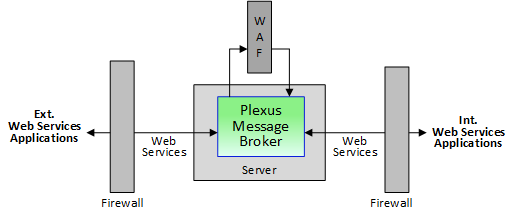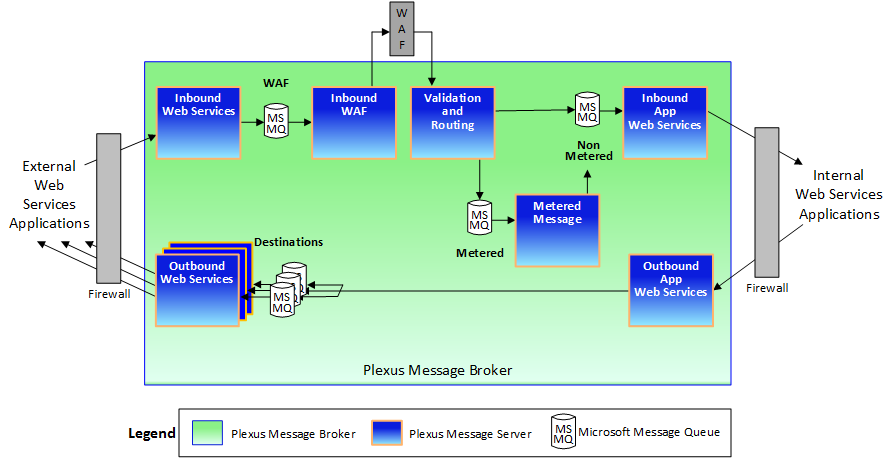Emergency Services
Technical Summary
- Healthcare
- Emergency Services
- Mgmt. Summary
- Technical Summary
- Justice/Law Enforcement
- Unemployment Benefits
- Legacy Terminals
- Public Safety
 This Plexus Message Broker solution features the following technology: Microsoft® MSMQ, Web Services, message flow control, message translation, and external intrusion detection appliances. This solution’s site and Plexus Message Broker configurations touch on these features below.
This Plexus Message Broker solution features the following technology: Microsoft® MSMQ, Web Services, message flow control, message translation, and external intrusion detection appliances. This solution’s site and Plexus Message Broker configurations touch on these features below.
Site Configuration
As illustrated below, this site has a single physical server that contains a single Plexus Message Broker instance connected to a single Web Application Firewall (WAF).
As with all Plexus Message Broker installations, adding physical servers, increasing Plexus Message Brokers instances per physical server, or transitioning to run the Plexus Message Broker in a virtual (VM) environment is only a matter of installation and configuration. No other Plexus Message Broker modifications are necessary.
It is equally possible to add WAF components as long as a load balancer is placed between the WAF and the Plexus Message Broker server. Resources are typically added for performance reasons, local redundancy reasons, or both.
Plexus Message Broker Configuration
There are seven different types of Plexus Message Servers in this Plexus Message Broker as illustrated below. On the inbound data path, a single instance of a Plexus Message Server is sufficient to manage the inbound message traffic. On the outbound path there is a separate Microsoft® MSMQ queue and a separate Plexus Message Server per destination. This configuration ensures that a bottleneck at one destination does not impact the message traffic to other destinations.
Plexus Message Server Functions
| Message Server | Function |
| Inbound Web Services | Receives Web Services call; verifies the sender has permission to perform the requested action; extracts the message and inserts the message into the MSMQ queue; responds that the inbound message was safely stored and will be processed |
| Inbound WAF | Removes a message from the MSMQ queue and initiates a Web Services call passing the message to the WAF |
| WAF | An intrusion detection device that checks internet message for viruses. Sends a Web Services Status Notification to the Inbound WAF indicating the safety of the message. |
| Validation and Routing | Receives a Web Services call from the WAF containing a message that has passed the intrusion detection tests; validates the application schema; routes metered messages to the metered queue, others to the non-metered queue |
| Metered Messages | Removes messages from the metered queue in a fashion that does not flood the system |
| Inbound App Web Services | Removes messages from the non-metered queue; wraps message in an internal application SOAP header; executes a Web Services call to the back-end application |
| Outbound App Web | Receives a Web Services call from the back-end application; validates the message and inserts the message into the correct destination queue |
| Outbound Web Services | Receives a message from a destination queue; wraps the message in the destination’s SOAP header; and sends to destination via Web Services |


